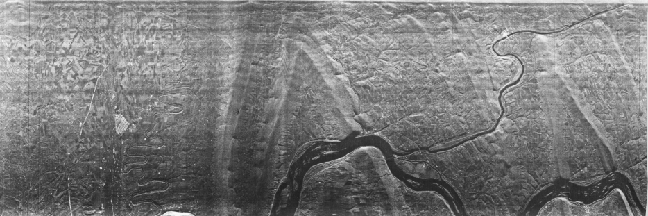

Other factors contribute to the brightness or intensity of the returned signal. Two properties of materials provide clues about composition and surface state by the manner in which these attributes interact with the incoming pulses. One is the dielectric constant (Symbol is the small Greek letter k, a dimensionless number determined as the ratio of the capacitance of a material to that of a vacuum [set at 1.00]; this is an electrical property that relates to a material's capability [capacity] to hold a charge), which is a measure of the degree of polarizability of a material subjected to an applied electric field. Radar waves penetrate deeper into materials with low dielectric constants and reflect more efficiently from those with high constants. Values for k range from 3 to 16 for most dry rocks and soils up to 80 for water with impurities. Moist soils have values typically between 30 and 60. Thus, variation in intensities of reflected pulses may, other factors being held constant, indicate differences in soil moisture. Variations among rocks is generally too small to distinguish most types by this property alone.
Second, surfaces representing various kinds of materials differ
from one another in their natural or cultivated state of roughness. Roughness, in this sense, refers to irregularities of dimensions that relate either to textures of the surfaces or of
objects on them (such as close-spaced vegetation which may assume
a variety of shapes). Examples include the surficial character
of pitted materials, granular soils, gravel, grass blades, and
other covering objects whose surfaces have dimensional variability
of the order of millimeters to centimenters. The height of an
irregularity, together with radar wavelength and grazing angle
at point of contact, determines the behavior of a surface as smooth
(specular reflector), intermediate, or rough (diffuse reflector).
A surface with an irregularity height averaging 0.5 cm will respond
to K ![]() band (
band ( ![]() = 0.85 cm), X band (
= 0.85 cm), X band ( ![]() = 3 cm), and L band (
= 3 cm), and L band ( ![]() = 25 cm) radar waves in the reflection sequence of smooth, intermediate,
and rough respectively. Other average heights produce different
responses, from combinations of "all smooth" to "all rough" for
the several bands used. This opens the possibility of a radar
broadcasting three bands simultaneously in a quasi-multispectral
mode, from which color composites can be produced by assigning
a color to each band (see below). Patterns of relative intensities
(as gray levels) for images made from different bands may serve
as diagnostic tonal signatures for diverse materials whose surfaces
show contrasted roughness.
= 25 cm) radar waves in the reflection sequence of smooth, intermediate,
and rough respectively. Other average heights produce different
responses, from combinations of "all smooth" to "all rough" for
the several bands used. This opens the possibility of a radar
broadcasting three bands simultaneously in a quasi-multispectral
mode, from which color composites can be produced by assigning
a color to each band (see below). Patterns of relative intensities
(as gray levels) for images made from different bands may serve
as diagnostic tonal signatures for diverse materials whose surfaces
show contrasted roughness.

Signals for all common radar bands pass through the fine droplets of moisture making up clouds, so that this condensation is effectively transparent or invisible to the beam. However, large ice crystals or raindrops do backscatter K band radiation. Weather radar relies on this band interval to "picture" clouds and determine their movement using the Doppler effect (frequencies will shift depending on motion toward or away from the receiver).
Code 935, Goddard Space Flight Center, NASA
Written by: Nicholas M. Short, Sr. email: nmshort@epix.net
and
Jon Robinson email: Jon.W.Robinson.1@gsfc.nasa.gov
Webmaster: Bill Dickinson Jr. email: rstwebmaster@gsti.com
Web Production: Christiane Robinson, Terri Ho and Nannette Fekete
Updated: 1999.03.15.